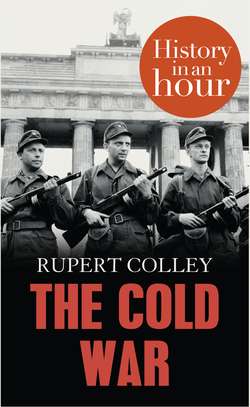Читать книгу The Cold War: History in an Hour - Rupert Colley - Страница 11
ОглавлениеThe Bomb: ‘MAD’
On 29 August 1949, in the Kazakhstan desert, Soviet scientists, under the leadership of Lavrenti Beria, Stalin’s chief of secret police, successfully detonated their first atomic bomb, four years after the bombing of Hiroshima and Nagasaki. When the Americans found out they were shocked – they had anticipated that it would take the Soviets until at least 1953 to reach that stage. Armed with information gleaned from spies working for the US atomic industry and with the use of forced labour, the Soviet Union had broken the US’s monopoly. The US then upped the stakes by developing the hydrogen bomb, despite fears that such bombs threatened the very existence of life on earth. But the very thought that the Soviets would develop their own ‘superbomb’ forced the US hand, and on 1 November 1952, on a tiny Pacific island, the US tested the world’s first hydrogen bomb, 1,000 times more powerful than the atomic bomb dropped on Hiroshima.
Less than a year later, on 12 August 1953, the Soviets did indeed test their own H-bomb. The race continued. In March 1954 the Americans detonated a lithium-based hydrogen bomb, the fallout spattering a Japanese fishing boat, the Lucky Dragon, eighty-two miles away. The unlucky crew members fell ill, one eventually dying. In October 1961 the Soviet Union successfully tested the world’s largest bomb – a single explosion that exceeded all explosives used throughout the whole of the Second World War.
The US, concerned over a perceived ‘missile gap’, increasingly used spy planes over Russia to gather information on the strength of the Soviet nuclear capacity. Khrushchev was furious about these intrusions over Soviet airspace but the US U-2s were able to fly at too high an altitude to be brought down. However, in May 1960, days before a four-power summit in Paris, a Soviet fighter plane did finally bring down a U-2. At first Eisenhower insisted it was not a spy plane but a weather plane. But when Khrushchev provided firm evidence, Eisenhower had to confess. Khrushchev then boycotted the Paris talks and relations between the superpowers deteriorated. The U-2 pilot, Gary Powers, was sentenced to ten years imprisonment but released after two in exchange for a Soviet spy in US captivity.
The superpowers knew that these bombs could not be used against each other – to do so would destroy each other and would make the world uninhabitable. To the end of the Cold War the very existence of humanity lay in this fragile balance of deterrence, known as Mutually Assured Destruction or, rather aptly, MAD. The time had come to discuss how to slow down the arms race, and the first of many, rather meaningless, agreements came in 1963 with the signing of the Limited Test Ban Treaty.
